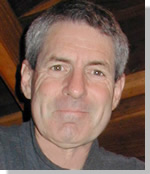 On The Road
On The Road
by: Bill Oetinger 1/1/2011
The Top Ten of 2010
It's the end of 2010 and the beginning of 2011. That means it's time for a retrospective look at the year just laid to rest. In the waning days of any given year, newspaper editors will inevitably assign some staff writer the task of compiling a top ten list of big moments that captured our attention over the past 12 months. Cycling websites are no different, sometimes polling their readers to assist in the task of coming up with a hot list.
It occurs to me that, in all my years of scribbling this column, I have never indulged in this annual rite of passage. This year, bereft of any better ideas for a January column, I'm going to finally take the plunge and cobble together my own top ten list. I'll dub it my Top Ten Cycling Highlights of 2010. They aren't necessarily the greatest or best accomplishments of the year, although most of them would make any such list. Mostly, they're just the moments that caught my eye and made me happy to be associated with this grand old game.
It's the prevailing convention with any top ten list that it be packaged in the form of a countdown to Number 1. I will honor that convention and attempt to rank these in some order of importance, but I do so only grudgingly and with the disclaimer that all of these highlights are special to me, with very little separating them in any ranking. With that in mind, let me begin at number 10…
10. Alessandro in Green
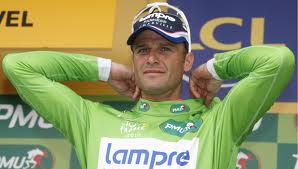 Being a creaky, old geezer myself, I have a special fondness for some of the older war horses in the pro peloton, especially if they also happen to be old school gents with a lot of class. Alessandro Pettachi fits that description in my book. He turns 37 the week this column hits the street, fairly ancient for a serious sprinter. He's not quite the dominant force in the field sprints that he was in his prime, but he can still win big races, and he proved that again this year with two stage wins and the green jersey of best sprinter in this year's Tour de France.
Being a creaky, old geezer myself, I have a special fondness for some of the older war horses in the pro peloton, especially if they also happen to be old school gents with a lot of class. Alessandro Pettachi fits that description in my book. He turns 37 the week this column hits the street, fairly ancient for a serious sprinter. He's not quite the dominant force in the field sprints that he was in his prime, but he can still win big races, and he proved that again this year with two stage wins and the green jersey of best sprinter in this year's Tour de France.
Back in his heyday, when he was almost unbeatable, he never finished a full Tour de France, so although he won many stages--46 Grand Tour stages in all--he never before got to wear the maillot vert in Paris. Now he has that jersey to go with the best-sprinter jerseys he already owns from the Giro d'Italia and Vuelta a España. I don't know how many other sprinters have won the points jerseys in all three Grand Tours, but I'm going to guess it’s a pretty short list.
9. Cadel on the Mur de Huy
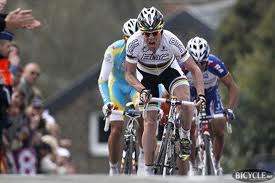 Cadel Evans came into 2010 wearing the rainbow stripes of World Champion. Some folks think wearing the rainbow bands acts as a jinx on a rider; that his year in the jersey is filled with disappointment and failed expectations. I've never looked at the results, year in and year out, to see if this really is true, but in the case of Evans, it was pretty much the case. He did some good things, but not as much as he or his fans had hoped he would. He came close at the Giro, winning one wonderful stage and finishing second in an epic time trial before fading to 5th. He flirted with the lead in the Tour before fizzling out entirely. It was that kind of year.
Cadel Evans came into 2010 wearing the rainbow stripes of World Champion. Some folks think wearing the rainbow bands acts as a jinx on a rider; that his year in the jersey is filled with disappointment and failed expectations. I've never looked at the results, year in and year out, to see if this really is true, but in the case of Evans, it was pretty much the case. He did some good things, but not as much as he or his fans had hoped he would. He came close at the Giro, winning one wonderful stage and finishing second in an epic time trial before fading to 5th. He flirted with the lead in the Tour before fizzling out entirely. It was that kind of year.
However, he did have one day that was a complete, unalloyed success: he won the first classic of his career at Flèche Wallone on April 21. He did it with a finely judged blend of patience, power, and panache. Flèche Wallone ends with a brutal final kilometer ascending the legendary Mur de Huy, all of it in the high teens for gradient and a good bit of it at a leg-breaking, lung-baking 20%. When the sharp end of the peloton flew under the 1-km banner, various riders launched off the front to try their luck. Andreas Klöden was the first to go and immediately got a nice gap. But the hill is too long and too steep, and that move was way too early. He soon ran out of steam and was almost at a standstill when Igor Anton blew past, with Alberto Contador on his wheel. These two looked like the real deal, setting a killer tempo up the steepest pitch. Anton would go on to win a similar finish on a stage in this year's Vuelta, but on this wall, he too ran out of gas. Contador came around him, and as perhaps the greatest climber in the world right now, that looked for a few seconds to be game over. Who was going to come around Contador?
Cadel Evans, that's who. Halfway up the hill, he looked to be completely gapped, with no shot at coming back to the front. But he rode his own race and slowly nibbled away at the Anton-Contador gap, wrasslin' with his bike in his usual ungainly style. Just as Contador finally got around Anton, Evans made contact behind them, and then, with only a few yards to go, he chugged past a thoroughly gassed Contador and shoved his bike across the line first. I just watched the video of this final kilometer again and it's as exciting now as it was back in April.
So hat's off to Cadel. His rainbow jersey season wasn't all he had wished it would be, but on this day at least, he looked every inch the World Champion.
8. Levi’s August Double
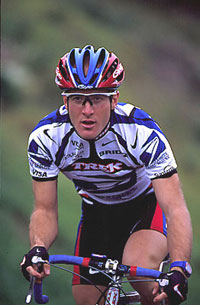 Another rider whose 2010 season didn't live up to expectations was Levi Leipheimer. He only finished third in a rather lackluster Tour of California--an event he almost owned in previous years--and he somehow managed to tank on the Tourmalet at the Tour, turning a potential top-five finish into a 13th overall. Not at all what he envisioned back in January. However, he did manage to salvage something out of this otherwise ho-hum year with a most unconventional double in mid-August, both triumphs coming in the Rocky Mountains.
Another rider whose 2010 season didn't live up to expectations was Levi Leipheimer. He only finished third in a rather lackluster Tour of California--an event he almost owned in previous years--and he somehow managed to tank on the Tourmalet at the Tour, turning a potential top-five finish into a 13th overall. Not at all what he envisioned back in January. However, he did manage to salvage something out of this otherwise ho-hum year with a most unconventional double in mid-August, both triumphs coming in the Rocky Mountains.
On August 14, he entered his first official mountain bike race ever: the prestigious Leadville 100. Six hours and 16 minutes later, he was the winner, lopping a whopping 12 minutes off the course record set last year by his famous teammate Lance Armstrong, despite having crashed hard early in the race. In his typical self-effacing manner, he declared the race "ridiculously hard." Maybe so, but he still won, nine minutes clear of the next rider.
Three days later, he started the Tour of Utah, a five-stage race billed, somewhat grandiosely, as "the hardest stage race in America." He took the lead by winning Stage 2, the event's big mountaintop finish at Mt Nebo, putting 51 seconds into Paco Mancebo, the defending champion. Then he backed that up with a great time trial the next day, losing by one second to bright young star Taylor Phinney but widening his lead over Mancebo by another 41 seconds.
After that, he hung in there over the final two stages, staying safe in the middle of the pack. You might assume his RadioShack team worked hard to protect him, but you would be wrong. There was no team. Against all the best teams in North America, Levi was entered solo...a team of one.
So in the space of one week, he enters his first-ever serious mountain bike race and wins it going away. Then he enters a tough stage race without a team to support him and wins that event too. Whether it's the hardest stage race in the country is somewhat beside the point. It's a hard race and had all the hard boys in the field, all working with their teams. He still came out on top.
It may add up to a rather off-beat consolation prize after the missed opportunity at the Tour de France, but it's still a rather remarkable achievement.
7. Chris Horner’s Surprise
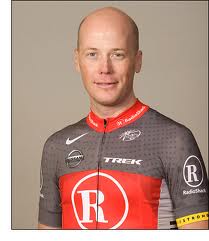 Here's another tip of the hat to the old fogies in the peloton, in this case, 39-year old Chris Horner. The surprise in the header refers in particular to his winning the Vuelta Ciclista al Pais Vasco, a six-stage race in Spain in early April. He won it by staying close on the two big mountain stages--tied for second at :02 and tied for second at :14--and then by clobbering them all in the final day's time trial, finishing up seven seconds clear of Alejandro Valverde. But the "surprise" might also apply to his ending up in the top ten at the Tour de France, the highest placed American in the field…this, in spite of riding as a domestique for Levi and Lance.
Here's another tip of the hat to the old fogies in the peloton, in this case, 39-year old Chris Horner. The surprise in the header refers in particular to his winning the Vuelta Ciclista al Pais Vasco, a six-stage race in Spain in early April. He won it by staying close on the two big mountain stages--tied for second at :02 and tied for second at :14--and then by clobbering them all in the final day's time trial, finishing up seven seconds clear of Alejandro Valverde. But the "surprise" might also apply to his ending up in the top ten at the Tour de France, the highest placed American in the field…this, in spite of riding as a domestique for Levi and Lance.
Chris seems to have been around forever, sometimes as a star and team leader but more frequently in recent years as a hard-working support rider for some other, more illustrious leader. He has soldiered on, year after year, through more bumps and bruises and broken bones than any three rodeo cowboys, and he just keeps coming back for more. If you want to think of his inclusion in my Top Ten list as a sort of lifetime achievement recognition, that's fine with me.
6. Oscar's Bookends
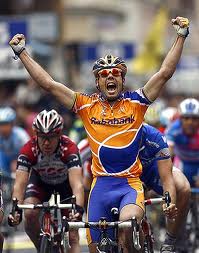 Finally, one more for the old boy network: this time I'm saluting 34-year old Oscar Freire of Spain (35 next month). Okay, that's not so old, but it seems as if he's been around a lot longer than the 12 or 13 years of his pro career, having been World Champion three times already and having been a fixture in the world of sprint finishes for such a long time. All racers spend a lot of time injured or laid up with this or that chronic debility, and Freire has had more than his share of troubles in this department. Reports on his assorted injuries and ailments pop up so often, it seems as if he ought to be washed up, worn down by the toll of so many wrecks and wretched reversals, ready to announce his retirement…but then he pulls another rabbit out of the hat and does something marvelous to add to his palmarès…
Finally, one more for the old boy network: this time I'm saluting 34-year old Oscar Freire of Spain (35 next month). Okay, that's not so old, but it seems as if he's been around a lot longer than the 12 or 13 years of his pro career, having been World Champion three times already and having been a fixture in the world of sprint finishes for such a long time. All racers spend a lot of time injured or laid up with this or that chronic debility, and Freire has had more than his share of troubles in this department. Reports on his assorted injuries and ailments pop up so often, it seems as if he ought to be washed up, worn down by the toll of so many wrecks and wretched reversals, ready to announce his retirement…but then he pulls another rabbit out of the hat and does something marvelous to add to his palmarès…
This year, his big highlights were two, and I call them bookends because they came at opposite ends of the season.
On March 20, he opened his season in spectacular fashion by winning the first classic of the year, Milano-San Remo (for the third time). While other riders launched attacks on the final climb over the Poggio, he bided his time and stayed close, letting others do the work of bringing back the assorted attackers. Finally, it came down to a small field sprint for the elite group of survivors who had weathered the mayhem on the Poggio--climb and descent both--and he played his cards perfectly, sling-shotting off another team's lead-out and finishing a comfortable bike length ahead of Tom Boonen and the rest of the bunch.
On October 10, he got his other bookend by winning the last one-day classic of the season, Paris-Tours. In doing so, he ran off the 233-km race at an average speed of 47.73 km per hour. (145 miles at 29.49 mph.) That earns him the distinction of having set the the record for the fastest average speed ever in a classics race.
5. Ivan on Zoncolan
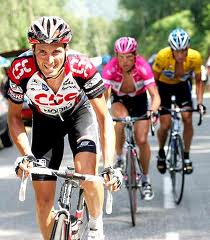 Out of the doghouse for his doping transgressions, Ivan Basso was back to his best form this spring, winning the Giro d'Italia for the second time. As is the case in any three-week Grand Tour, there were many moments on many stages that contributed to his overall victory. But for my Highlight Zone moment, I am selecting the monstrous mountain finish atop Monte Zoncolan on May 23. It seems to embody all the best elements that Basso brings to racing. If you care to read more about it, I covered the Giro in my June column.
Out of the doghouse for his doping transgressions, Ivan Basso was back to his best form this spring, winning the Giro d'Italia for the second time. As is the case in any three-week Grand Tour, there were many moments on many stages that contributed to his overall victory. But for my Highlight Zone moment, I am selecting the monstrous mountain finish atop Monte Zoncolan on May 23. It seems to embody all the best elements that Basso brings to racing. If you care to read more about it, I covered the Giro in my June column.
Zoncolan is a relative newcomer amongst the famous climbs in bike racing, having first appeared in the 2003 Giro and only twice more since then. There are three roads to the summit, and by far the most challenging is the road up from Ovaro, which they used this year. The main climb is about 10 km and averages 12%, with the steepest pitches topping out at 22%. That is seriously hard work for anyone, and especially hard at race pace, midway through a Grand Tour.
There were no extenuating circumstances on this stage, aside from a couple of big summits to be crested before the final one. No crashes, no confusion. A couple of dozen serious contenders reached the bottom of the final climb more-or-less within striking distance of the lead, and then it was just a matter of seeing who could get up the brutal ascent fastest. As in all such tests, the various contenders turned into pretenders, one by one, as their legs couldn't get the job done any longer. Finally, only Basso and Cadel Evans were left, trailing a long string of blown riders behind them. And then Basso, looking composed and quiet on the bike, sitting down most of the time, rode away from Evans. It wasn't easy. Not at all. But Basso made it look as if it were, while Evans writhed and struggled behind him, trying to limit his losses.
In the end, Evans conceded 1:19 to Basso. It wasn't a huge amount of time lost, and in fact he got about a third of that total back on the next stage (an uphill time trial). It didn't even win Basso the maglia rosa. But it was enough: it stamped his mark of authority on the Giro. Even without the leader's jersey, he became the favorite, and in a matter of days, he delivered on that promise, taking the lead and keeping it to the finish.
Basso's win atop Monte Zoncolan wasn't spectacular. He's not really a spectacular rider. He wins with an elegantly efficient style. Whether that makes him more or less of a campionissimo, I can't say. All I know is that, on this day, on the hardest of all the mountains, he was hardest of all the men.
4. Mara at the Giro
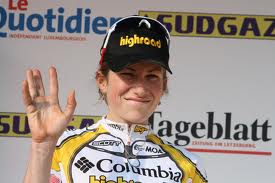 Mara? Who dat? If you were asked to name an American rider who won a really prestigious stage race in 2010, you might have to scratch your head and think about it for awhile…maybe even say, "I give up!" Unless you're a really astute follower of the racing circus, you may have missed the fact that Mara Abbott of the good old USA won the women's version of the Giro d'Italia this year, in July. (Officially known as the Giro Ciclistico Internazionale Femminile, this big stage race is usually referred to simply as the Giro Donne.)
Mara? Who dat? If you were asked to name an American rider who won a really prestigious stage race in 2010, you might have to scratch your head and think about it for awhile…maybe even say, "I give up!" Unless you're a really astute follower of the racing circus, you may have missed the fact that Mara Abbott of the good old USA won the women's version of the Giro d'Italia this year, in July. (Officially known as the Giro Ciclistico Internazionale Femminile, this big stage race is usually referred to simply as the Giro Donne.)
Mara took control of the race with dominant victories in two back-to-back mountain stages, the second of which finished atop the epic Stelvio. (I can't remember the last time a men's Giro stage finished at the top of the Stelvio. They usually go up and over and down the other side and on to other things. I've always thought it would make a great finish, but this is the first time I've ever seen one.) Those two victories were all she needed to secure the general classification, joining Andy Hampsten as the only Americans to win the big one in Italy. She was second last year.
To add a little frosting to the cake, two other members of the US National Team won stages as well: Evelyn Stevens won another mountain finish on Stage 7 and Shelley Evans won the final stage. It would be nice if all of these women were as well known to cycling fans as Levi and Lance and the rest of our road warriors.
3. Vinnie at the Vuelta
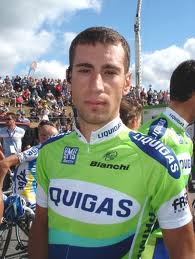 Vincenzo Nibali won the 2010 Vuelta a España. I wrote about that race just three months ago. In that report, I said it might have been the best of the three Grand Tours of the year, at least in terms of spectator entertainment. It was constantly interesting and exciting, from beginning to end, and it wasn't decided until the final few yards of the final climb on the penultimate stage. Those final few yards are my defining highlight of the Vuelta.
Vincenzo Nibali won the 2010 Vuelta a España. I wrote about that race just three months ago. In that report, I said it might have been the best of the three Grand Tours of the year, at least in terms of spectator entertainment. It was constantly interesting and exciting, from beginning to end, and it wasn't decided until the final few yards of the final climb on the penultimate stage. Those final few yards are my defining highlight of the Vuelta.
Nibali entered that final mountain stage with a 50-second lead over the mercurial mountain goat Ezequiel Mosquera, but with the brutal climb to the top of Bola del Mundo on the card, that was by no means a safe lead. Sure enough, as soon as the leaders turned onto the steep little track up to the radio towers, Mosquera took off like the proverbial scalded cat. Nibali set off in pursuit. For awhile, as they climbed through the dense mist, along a narrow canyon of screaming fans, it looked as if Mosquera might pull away enough. But Nibali hung tough, only conceding a few seconds. Then, near the top, he actually pulled Mosquera back, reeling him in, yard by painful yard. Finally, just before the finish line, he pulled up right alongside Mosquera, entirely erasing any advantage the aggressor might have built up with all his ferocious attacking.
Mosquera won the stage, probably because Nibali let him have it. But Nibali won the stage race, and he did it with style and guts. It was as exciting a bit of racing as I saw all year. It was classic. It was epic. I loved it. I noted in my review of that race that Vincenzo Nibali is the only racer to stand on the podiums of two Grand Tours this year, as he also finished third at the Giro while riding in support of his team captain, Basso. He's still just coming into his prime. I look for much more from him in the future.
2. Andy and Alberto
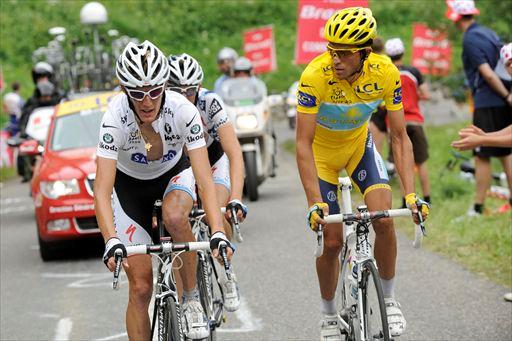 I don't rate this year's Tour de France as one of the great tours of all time, and now that the winner, Alberto Contador, is living under a cloud of suspicion about an alleged doping violation, it's even harder to get excited about it. But like all Grand Tours, it did have its moments of thrilling action and suspense, of strategy and intrigue. And because it is the Tour--the biggest and hardest race of them all--we have to pay attention to it and revel in it, even if it wasn't the best Tour ever. Naturally, I wrote a column about it at the time. If you haven't already read that tome, you can do so here.
I don't rate this year's Tour de France as one of the great tours of all time, and now that the winner, Alberto Contador, is living under a cloud of suspicion about an alleged doping violation, it's even harder to get excited about it. But like all Grand Tours, it did have its moments of thrilling action and suspense, of strategy and intrigue. And because it is the Tour--the biggest and hardest race of them all--we have to pay attention to it and revel in it, even if it wasn't the best Tour ever. Naturally, I wrote a column about it at the time. If you haven't already read that tome, you can do so here.
The moment from the Tour that I'm choosing for my defining highlight moment should be obvious to anyone who followed the Grand Boucle: that would be the moment of Andy Schleck's missed shift on Stage 15. You all know what happened: with a slim lead in hand, Andy attacked off the front of a much-diminished lead group near the summit of a big climb, but in the process of shifting gears while accelerating, out of the saddle, he somehow jammed his chain and locked everything up, to the point that he had to dismount and jigger it free again. Meanwhile, his nearest rivals--Alberto Contador, Denis Menchov, and Sammie Sanchez--were in full chase mode and flew past him while he was grappling with his chain. They crested the summit just a wee bit ahead but then poured on the coal all the way down the 21-km descent to the finish line, opening up a gap that gave the lead to Contador…a gap Schleck was never able to close over the final week of the race.
I'm not going to rehash the old debate about whether Contador should have waited for Schleck. In my first column, I weighed the pros and cons of it, deciding there was no clear-cut right answer. I did hint a bit that he might have waited, but I didn't beat him up for it too much. I will only note that since then, I have kicked this around with a lot of other cycling fans, including both recreational riders and some serious racers. Pretty much everyone agrees that Contador need not have waited; that Schleck's "mechanical" was his own fault and happened while he was attacking and because he was attacking, and therefor Alberto was entirely within his rights--by any interpretation of cycling's gentlemen's agreements--to have left Andy to mess around with his chain.
As with all of the other stage races mentioned here, there were other significant and decisive moments in this year's Tour de France; other moments that had a bearing on the final results. But that little hiccup on Stage 15 is the one folks are going to remember for years to come.
1. Fabian's Cobbled Double
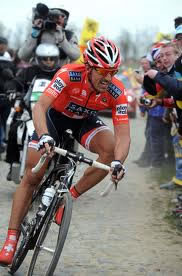 On back-to-back Sundays in April, Swiss national champion Fabian Cancellara did what very few riders have done before: he swept the greatest monuments of the spring classics season, winning the Tour of Flanders and Paris-Robaix. For good measure--just to make sure we understand he's the champ--he won the semi-classic E3 Prijs Vlaanderen-Harelbeke the week before Flanders. In all three races, he beat the same roster of top guns, in particular Tom Boonen, two-time winner of Flanders and three-time winner of Paris-Roubaix.
On back-to-back Sundays in April, Swiss national champion Fabian Cancellara did what very few riders have done before: he swept the greatest monuments of the spring classics season, winning the Tour of Flanders and Paris-Robaix. For good measure--just to make sure we understand he's the champ--he won the semi-classic E3 Prijs Vlaanderen-Harelbeke the week before Flanders. In all three races, he beat the same roster of top guns, in particular Tom Boonen, two-time winner of Flanders and three-time winner of Paris-Roubaix.
On the Ronde van Vlanderen, Cancellara and Boonen dropped all the other hopefuls on the Molenberg climb, with 40 km to go. Thanks to a helpful tailwind, they were able to widen their gap over a small group of chasers. Then, on the famous Kapelmuur--the wall beside the chapel--with about 20 km to go, Cancellara surged again. This time, Boonen couldn't stay with him. I have a large photo of that moment in front of me on my desk right now: Cancellara putting the hammer down on the steepest part of that very steep, cobbled climb. He's sitting down. The muscles in his legs tell you he's working hard, pumping out the power, but his face looks almost serene…almost as if he's having fun.
Boonen never gave up, but he never got back on terms with him. He lost just a few seconds on the climb, but once over the top, Cancellara--the time trial world champion--just kept hammering, all the way to the finish, at which point his margin of victory was up to 1:15.
One week later, it was deja vu all over again. Paris-Roubaix is dead flat. There are no murs or bergs to climb, where selections might be made. Instead, there are the long sectors of bone-shaking cobbles…muddy if they're wet or dusty if they're dry. The challenge is as simple as it can be: ride faster than everyone else. On this Sunday, Cancellara was again the man to do just that. With about 50 km to go, he simply rode everyone off his wheel. Afterward, he said he hadn't planned to attack at exactly that point. It just seemed like the right moment. He got a little gap and that was all it took. Once they lost his wheel, all the other riders were fighting for second place. He used his daunting time trialing strength to ride off into the distance, opening a gap of 2:00 by the time he rolled into the Roubaix velodrome for his ceremonial last lap.
It was such a dominating, intimidating show of strength. All the other riders--those who were even close enough to see him make his decisive moves--agreed that, at least for this year, he's on another level, maybe even another planet. So dominant was he, that a rumor took hold that he must have a battery pack secreted in his seat tube. (This absurdity was proposed primarily by retired Italian racer and TV commentator Davide Cassani, thereby guaranteeing himself a spot in the Blithering Idiots' Hall of Fame.)
Silly rumors aside, all honor to Fabian Cancellara, who rolled off an April for the ages. The last person to do the Flanders-Roubaix double was his chief rival this year, Tom Boonen, five years ago. When asked if he had a solution for beating Cancellara, Boonen said: "shoot him!"
Alright then…that's my list. I might have selected Thor Hushovd, the jolly Norse hammer, winning the World Championship in Australia. I might have tipped the hat to Levi Leipheimer's amazing King Ridge Gran Fondo…6000 riders strong. Or to 20-year old Taylor Phinney, winning the US time trial championship, the World Individual Pursuit Championship (again), and the Under-23 Paris-Roubaix. If I flipped back through the race reports for the year, I could probably find a few more gems to present to you. Maybe even a Top 20 list. But I'm satisfied with my list.
I hope your year contained some version of a personal Top Ten Highlights list: days when you got all your ducks in a row and rode well and happily. When you caught that perfect tailwind and the sun beamed down and all was right in your world. I wish you good luck, good health, great fitness, and safe riding in 2011.
Bill can be reached at srccride@sonic.net

